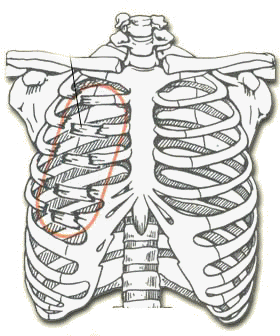Chest Injuries
DEFINITIONS:
Chest injury: any injury to the thoracic cage and it's contents, including the lungs, heart, great vessels, and oesophagus.
Causes of chest injury:
Blunt Trauma
Penetrating
Blunt chest injuries are characterized by
- Mechanism:
-
- Severe blunt force applied to the chest.
- Rapid deceleration injury.
- Signs:
-
- Chest wall deformity.
- Chest wall contusion.
- Chest wall laceration.
- Severe trauma above the chest (i.e., head injury) and below the chest (i.e., abdominal or pelvic injury),
- Symptoms:
-
- Tachypnoea.
- Pain.
- Absent breath sounds.
- Crepitance or subcutaneous emphysema.
- Haemoptysis.
- Discordant breathing pattern.
- Hypotension.
- Distended neck veins
Penetrating chest injuries
- Mechanism
-
- Gunshot
- Stab
Consider the possibility of the following chest injuries:
Tension pneumothorax
A complete collapse of the lung that occurs when air enters, but does not leave, the pleural space. A mediastinal shift (displacement of the organs of the chest to the opposite side) occurs.
Causes
In tension pneumothorax, air enters the pleural space with each breath, is not expelled by exhaling, and becomes trapped. The trapped air builds up pressure in the chest, as the amount of trapped air accumulates. If untreated, the lung collapses on the affected side and may cause a mediastinal shift in which the heart, trachea, oesophagus, and great vessels are pushed towards the unaffected side of the chest. The shift may cause compression of the opposite lung and may affect the flow of blood returning to the heart
Symptoms:
- Sudden chest pain
- Dyspnoea
- Chest tightness
- Easy fatigue
- Cyanosis of the skin due to lack of oxygen
- Rapid heart rate (Tachycardia)
- Low blood pressure
- Decreased mental alertness
- Wheezing
- Consciousness, decreased
- Tachypnoea
- Distended neck veins (the veins in the neck appear to bulge)
Haemothorax
A haemothorax relates to the presence of blood in the pleural cavity. It is almost always the result of a fractured rib piercing the lung or surrounding tissue, or of a penetrating chest wound.
Symptoms
Chest injuries have general signs and symptoms as listed under Tension Pneumothorax.
Flail Chest
Flail chest occurs when 2 or  more consecutive ribs break bilaterally
causing a separate floating section in the rib cage.
"Paradoxical chest wall motion" best describes a flail chest.
Paradoxical breathing can be described that on inhalation the
flail section moves inwards, expiration causes the section to
move outwards.
more consecutive ribs break bilaterally
causing a separate floating section in the rib cage.
"Paradoxical chest wall motion" best describes a flail chest.
Paradoxical breathing can be described that on inhalation the
flail section moves inwards, expiration causes the section to
move outwards.
Management
General management techniques as described below. You should try and protect the flail segment, this can be accomplished by using the patients own arm in a sling to act as a splint or lay the patient on the injured side. The first option will probably be a preferred procedure.
Open pneumothorax
Open pneumothorax, or sucking chest wound, occurs when air is drawn in through an open chest wound. With each breath air passes through the chest wall leading to accumulation in the chest cavity.
Management
General management techniques as described below but also put on a plastic dressing taped down on 3 sides to act as a seal to prevent more air being sucked in and causing a tension pneumothorax.
Spontaneous Pneumothorax
Spontaneous pneumothorax is a collection of air or gas in the chest that causes the lung to collapse, the rupture in the lung surface causes spontaneous pneumothorax. Usually it affects tall, thin men between 20 and 40 years old.
Fractured Ribs
Rib fractures occur when blunt trauma is inflicted on the casualty from i.e. sports injury or more commonly from road traffic crashes when the patient strikes the steering wheel or from the seat belt. Fractured ribs themselves are painful but more severe effects can occur as secondary/penetrating injuries i.e. haemothorax or pneumothorax. Rib fractures are more common in adults than children as the adult rib cage isn't as 'elastic' as children's ribs.
General Management Techniques
Administer high concentration of O2, Assisted ventilations if needed Patient positioning. Upright or semi-recumbent and inclined to the injured side
Continually monitor patient condition
Consider an ASHICE
Smooth and rapid journey to hospital
Professional handover to hospital staff